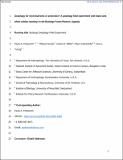Files in this item
Selecting between iron-rich and clay-rich soils : a geophagy field experiment with black-and-white colobus monkeys in the Budongo Forest Reserve, Uganda
Item metadata
| dc.contributor.author | Pebsworth, Paula A. | |
| dc.contributor.author | Gruber, Thibaud | |
| dc.contributor.author | Miller, Joshua D. | |
| dc.contributor.author | Zuberbühler, Klaus | |
| dc.contributor.author | Young, Sera L. | |
| dc.date.accessioned | 2021-07-15T23:39:32Z | |
| dc.date.available | 2021-07-15T23:39:32Z | |
| dc.date.issued | 2020-07-16 | |
| dc.identifier | 269224158 | |
| dc.identifier | 72c533a7-8ba8-49dc-b0ce-f099fc30f89e | |
| dc.identifier | 000549283000001 | |
| dc.identifier | 85087965488 | |
| dc.identifier.citation | Pebsworth , P A , Gruber , T , Miller , J D , Zuberbühler , K & Young , S L 2020 , ' Selecting between iron-rich and clay-rich soils : a geophagy field experiment with black-and-white colobus monkeys in the Budongo Forest Reserve, Uganda ' , Primates , vol. First Online . https://doi.org/10.1007/s10329-020-00845-y | en |
| dc.identifier.issn | 1610-7365 | |
| dc.identifier.other | RIS: urn:E6351D1A47890079AB7BC30133C52282 | |
| dc.identifier.other | RIS: Pebsworth2020 | |
| dc.identifier.other | ORCID: /0000-0001-8378-088X/work/77893633 | |
| dc.identifier.uri | https://hdl.handle.net/10023/23584 | |
| dc.description | T. G. was supported by the Swiss National Science Foundation (grants CR13I1_162720 and P300PA_164678). | en |
| dc.description.abstract | Geophagy, the intentional consumption of soil, has been observed in humans and numerous other animal species. Geophagy has been posited to be adaptive, i.e., consumed soil protects against gastrointestinal distress and/or supplements micronutrients. We conducted a field experiment in the Budongo Forest, Uganda, to investigate geophagic behaviors, including soil preference, the quantity of soil eaten, and competition for access to preferred soils. We placed pairs of artificial tree stumps at two existing geophagy sites. One stump contained soil from the surrounding area, Sonso, that could supplement bioavailable iron. The other stump contained soil from a neighboring community, Waibira, that was richer in clay minerals, which could provide protection from plant secondary compounds. We monitored activity and engagement with the stumps for 10 days using camera traps. After 5 days, we reversed the type of soil that was in the stumps at both sites (i.e., a crossover design). Only Colobus guereza (black-and-white colobus monkeys) interacted with the stumps. These monkeys used visual and olfactory cues to select between the two soils and exclusively ate the clay-rich soil, consuming 9.67 kg of soil over 4.33 h. Our findings lend the greatest plausibility to the protection hypothesis. Additionally, monkeys competed for access to the stumps, and 13% of the videos captured aggression, including pushing, excluding, and chasing other individuals from the experimental stumps. Nine episodes of vigilance and flight behavior were also observed. Given that intentionally ingested soil is a valuable resource that may confer health benefits, geophagy sites should be conserved and protected. | |
| dc.format.extent | 10 | |
| dc.format.extent | 2796754 | |
| dc.language.iso | eng | |
| dc.relation.ispartof | Primates | en |
| dc.subject | Soil eating | en |
| dc.subject | Detoxification | en |
| dc.subject | Bioavailable iron | en |
| dc.subject | Nonhuman primates | en |
| dc.subject | Field experiment | en |
| dc.subject | BF Psychology | en |
| dc.subject | NDAS | en |
| dc.subject.lcc | BF | en |
| dc.title | Selecting between iron-rich and clay-rich soils : a geophagy field experiment with black-and-white colobus monkeys in the Budongo Forest Reserve, Uganda | en |
| dc.type | Journal article | en |
| dc.contributor.institution | University of St Andrews. School of Psychology and Neuroscience | en |
| dc.contributor.institution | University of St Andrews. Institute of Behavioural and Neural Sciences | en |
| dc.contributor.institution | University of St Andrews. Centre for Social Learning & Cognitive Evolution | en |
| dc.identifier.doi | https://doi.org/10.1007/s10329-020-00845-y | |
| dc.description.status | Peer reviewed | en |
| dc.date.embargoedUntil | 2021-07-16 | |
| dc.identifier.url | https://rdcu.be/b5E8f | en |
This item appears in the following Collection(s)
Items in the St Andrews Research Repository are protected by copyright, with all rights reserved, unless otherwise indicated.

